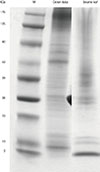Abstract
Oral allergy syndrome (OAS) is a subtype of food allergy composing of itching sense and edema in the oral cavity, lips, throat, pharynx, and larynx following ingestion of some fresh fruits or vegetables. Although the major pathogenic mechanism of OAS is known to be IgE-mediated response, here we experienced a case of OAS due to crown daisy (CD) and sesame leaf (SL) mediated by a non-IgE antibody mediated mechanism. A 33-year-old female visited our clinic to evaluate numbness of the tongue and gingiva after eating fresh CD and SL for 2 years. The patient had suffered from allergic rhinitis and atopic dermatitis for 20 years and took medications intermittently. There had been a history of food allergy to crab and shrimp. The serum total IgE level was elevated (404 kU/mL). The skin prick test showed strong positive reactions to tree and weed pollens, but not to CD and SL extracts. Enzyme-linked immunosorbant assay for detecting serum specific IgE to crude extracts of CD and SL showed negative results. The basophil activation test performed with crude extracts of CD or SL showed significant up-regulation of CD63-positive basophils by both CD and SL. In conclusion, we report a case of OAS due to CD and SL, not associated with pollen allergy, which is shown to be mediated by a non-IgE mediated mechanism.
Figures and Tables
 | Fig. 1Four to 20% sodium dodecyl sulphate-polyacrylamide gel electrophoresis (SDS-PAGE) finding of crown daisy and sesame leaf extracts. Protein bands ranged from 9 kDa to 175 kDa were detected by SDS-PAGE. |
 | Fig. 2Absorbance values of specific IgE to crown daisy (A) and sesame leaf (B) extracts by enzyme-linked immunosorbent assay in sera from the patient (•) with the oral allergy syndrome and normal controls (○). The horizontal lines indicate the cutoff level of positive results. |
 | Fig. 3Expression of CD63 in basophils induced by crown daisy (A) and sesame leaf (B) extracts in the patients with oral allergy syndrome. Up-regulation of CD63 positive basophils was noted with additions of crown daisy (A) and sesame leaf (B) extracts in dose dependent manners. Calcium ion (Ca++) is tested as a positive control. |
References
1. Egger M, Mutschlechner S, Wopfner N, Gadermaier G, Briza P, Ferreira F. Pollen-food syndromes associated with weed pollinosis: an update from the molecular point of view. Allergy. 2006; 61:461–476.

3. Webber CM, England RW. Oral allergy syndrome: a clinical, diagnostic, and therapeutic challenge. Ann Allergy Asthma Immunol. 2010; 104:101–108.

4. Korean Academy of Asthma, Allergy and Clinical Immunology. Asthma and allergic diseases. 2nd ed. Seoul: Ryo Moon Kak;2012. p. 445–471.
5. Dalal I, Goldberg M, Katz Y. Sesame seed food allergy. Curr Allergy Asthma Rep. 2012; 12:339–345.

6. Sicherer SH, Munoz-Furlong A, Godbold JH, Sampson HA. US prevalence of self-reported peanut, tree nut, and sesame allergy: 11-year follow-up. J Allergy Clin Immunol. 2010; 125:1322–1326.

7. Pajno GB, Passalacqua G, Magazzu G, Barberio G, Vita D, Canonica GW. Anaphylaxis to sesame. Allergy. 2000; 55:199–201.

8. Leduc V, Moneret-Vautrin DA, Tzen JT, Morisset M, Guerin L, Kanny G. Identification of oleosins as major allergens in sesame seed allergic patients. Allergy. 2006; 61:349–356.

9. Magni C, Ballabio C, Restani P, Fuggetta D, Alessandri C, Mari A, et al. Molecular insight into IgE-mediated reactions to sesame (Sesamum indicum L.) seed proteins. Ann Allergy Asthma Immunol. 2010; 105:458–464.

10. Beyer K, Bardina L, Grishina G, Sampson HA. Identification of sesame seed allergens by 2-dimensional proteomics and Edman sequencing: seed storage proteins as common food allergens. J Allergy Clin Immunol. 2002; 110:154–159.

11. Yoon TY, Choi KH, Lee KM, Ahn JY, Kim MK. Crown daisy-dependent exercise-induced anaphylaxis in a patient with Mugwort-sensitized Pollinosis. Korean J Asthma Allergy Clin Immunol. 2011; 31:63–66.
12. Shin YS, Choi GS, Park HJ, Ye YM, Park HS. A case of bronchospasm and urticaria caused by Shiso ingestion. Ann Allergy Asthma Immunol. 2009; 102:169.

14. Lack G. Clinical practice: food allergy. N Engl J Med. 2008; 359:1252–1260.
15. Wang J, Sampson HA. Food allergy: recent advances in pathophysiology and treatment. Allergy Asthma Immunol Res. 2009; 1:19–29.

17. Cho YS, Lim YJ, Lee JC, Kim SH, Lim MK, Yoo B, et al. Oral allergy syndrome in pollen - sensitized patients. J Asthma Allergy Clin Immunol. 1998; 18:458–465.




 PDF
PDF ePub
ePub Citation
Citation Print
Print


 XML Download
XML Download